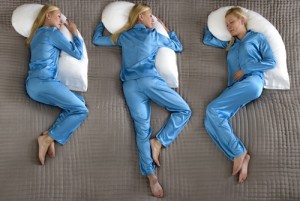 Sleep is an essential part of healing and managing pain. We need to get enough to function properly (8 hours), but quality sleep is most important. When we sleep our bodies are healing and repairing the damage done from the stress of the day, and naturally during this healing process our bodies need optimum circumstances. Everyone’s body is different, some positions will benefit others and some will hinder them depending on the aliment.
Sleep is an essential part of healing and managing pain. We need to get enough to function properly (8 hours), but quality sleep is most important. When we sleep our bodies are healing and repairing the damage done from the stress of the day, and naturally during this healing process our bodies need optimum circumstances. Everyone’s body is different, some positions will benefit others and some will hinder them depending on the aliment.
“Sleep allows us to rejuvenate the proteins in our body, in fact, rest helps with increasing the pain threshold of the body…if you have a particular back pain, neck pain, shoulder pain or hip pain then quality sleep will help you.” says Dr. Dembowski.
Many people can find sleeping during the night difficult. But there are always ways in which it can be improved. Some listen to the sound of rain while sleeping, as it helps calm them down and transports them to places such as the beach or holidays. Others people may like sleeping with a fan or air conditioning to keep them cool throughout the night. Someone I know use to have such a hard time going to sleep that he would always sleep with the air conditioning on. Unfortunately for him, the one time that he needed the fan for more than sleep (to keep him cool during a heat wave), the air conditioning stopped working. While he looked into finding a company would could deal with an air conditioning replacement, he had to use the small fan that was hidden away in the cupboard for months. For him, it wasn’t as effective, but he did manage to get a few good night’s sleep. You just need to try and find out what works best for you and your sleeping arrangements.
The three major sleeping positions are side, back, and stomach. Around 57% of people sleep on their side, according to a nationwide survey of over 2,000 people conducted by Tempur-Pedic North America. Lying on the back is the second most popular, with around 17% of people; followed by the stomach at 11% and the rest is varying positions throughout the night. Each position has variations, benefits and drawbacks. Make sure your sleeping position is correct for the area that is causing you the most pain.
If you suffer from…
Shoulder Pain: Try to avoid sleeping on your side if you have shoulder pain, the best position is on the back or on the opposite side of the hurt shoulder. Also place a pillow under the arm to support the shoulder.
Neck Pain: For neck pain try and keep the neck supported in a neutral position with a pillow above the shoulders, too many pillows may put the neck in a bent position. That can put stress on the vertebrae and cause damage to the disc. When dealing with neck pain avoid sleeping on the stomach.
Back Pain: To reduce back pain experts suggest sleeping on the back with a rolled up towel or pillow under the knees and under the small of the back. If you are sleeping on your side place a pillow between the knees for added support, and to aid the hips and knees.
Knee Pain & Hip Pain: Sleeping in the side or fetal position with a pillow between the knees can reduce pressure on the knees and hips, also if lying on the back place a pillow below the small of the back and under the knees to help alleviate pain.
Snoring / Sleep Apnea: Try to keep off your back, sleep on your side or stomach to reduced the threat of tongue collapsing or the relaxation of tissues in the throat which can hinder breathing.
Acid Reflex: Sleeping on the side is best for acid reflex most experts recommend sleeping on the left side. Sleeping on the back is not ideal for acid reflex but it can help alleviate symptoms if the head is propped up.
For those with sleeping problems it is not recommended to sleep on the stomach as it can cause back and neck pain. Use these helpful tips to find out your ideal sleeping position, but be sure to change it up once and a while as sleeping in the same position to often can cause problems. If these tips do not help you with your symptoms then contact our clinic for a free consultation. You may need medical attention to relieve the inflamed areas of the body and help you get a good night sleep.
Sources:
1.) Journal of Sleep Vol. 35:12 (2012)
2.) WebMD.com
3.) SleepAssociation.org
